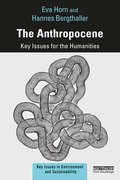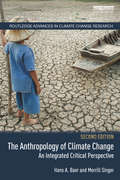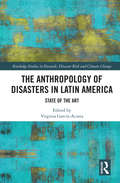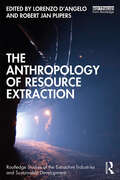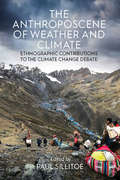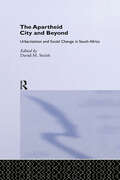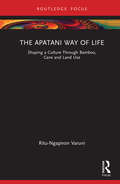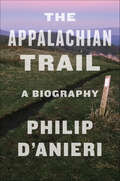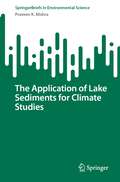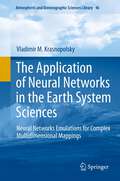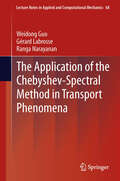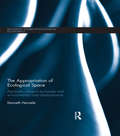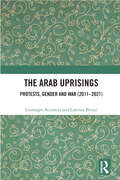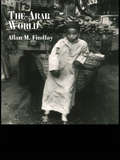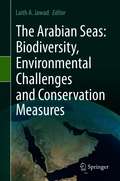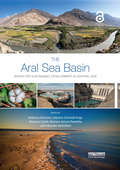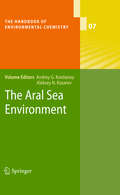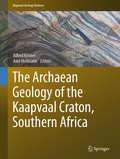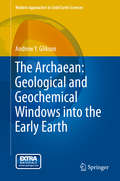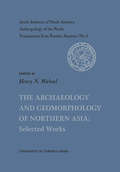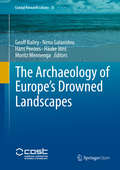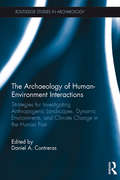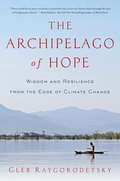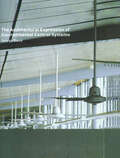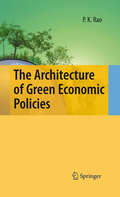- Table View
- List View
The Anthropocene: Key Issues for the Humanities (Key Issues in Environment and Sustainability)
by Eva Horn Hannes BergthallerThe Anthropocene is a concept which challenges the foundations of humanities scholarship as it is traditionally understood. It calls not only for closer engagement with the natural sciences but also for a synthetic approach bringing together insights from the various subdisciplines in the humanities and social sciences which have addressed themselves to ecological questions in the past. This book is an introduction to, and structured survey of, the attempts that have been made to take the measure of the Anthropocene, and explores some of the paradigmatic problems which it raises. The difficulties of an introduction to the Anthropocene lie not only in the disciplinary breadth of the subject, but also in the rapid pace at which the surrounding debates have been, and still are, unfolding. This introduction proposes a conceptual map which, however provisionally, charts these ongoing discussions across a variety of scientific and humanistic disciplines. This book will be essential reading for students and researchers in the environmental humanities, particularly in literary and cultural studies, history, philosophy, and environmental studies.
The Anthropology of Climate Change: An Integrated Critical Perspective (Routledge Advances in Climate Change Research)
by Merrill Singer Hans A. BaerIn addressing the urgent questions raised by climate change, this book provides a comprehensive overview of the anthropology of climate change, guided by a critical political ecological framework. It examines the emergence and slow maturation of the anthropology of climate change, reviews the historic foundations for this work in the archaeology of climate change, and presents three alternative contemporary theoretical perspectives in the anthropology of climate change. This second edition is fully updated to include the most recent literature published since the first edition in 2014. It also examines a number of new topics, including an analysis of the 2014 American Anthropological Association’s Global Climate Change Task Force report, a new case study on responses to climate change in developed societies, and reference to the stance of the Trump administration on climate change. Not only does this book provide a valuable overview of the field and the key literature, but it also gives researchers and students in Environmental Anthropology, Climate Change, Human Geography, Sociology, and Political Science a novel framework for understanding climate change that emphasizes human socioecological interactions.
The Anthropology of Disasters in Latin America: State of the Art (Routledge Studies in Hazards, Disaster Risk and Climate Change)
by Virginia Garcia-AcostaThis book offers anthropological insights into disasters in Latin America. It fills a gap in the literature by bringing together national and regional perspectives in the study of disasters. The book essentially explores the emergence and development of anthropological studies of disasters. It adopts a methodological approach based on ethnography, participant observation, and field research to assess the social and historical constructions of disasters and how these are perceived by people of a certain region. This regional perspective helps assess long-term dynamics, regional capacities, and regional-global interactions on disaster sites. With chapters written by prominent Latin American anthropologists, this book also considers the role of the state and other nongovernmental organizations in managing disasters and the specific conditions of each country, relative to a greater or lesser incidence of disastrous events. Globalizing the existing literature on disasters with a focus on Latin America, this book offers multidisciplinary insights that will be of interest to academics and students of geography, anthropology, sociology, and political science.
The Anthropology of Resource Extraction (Routledge Studies of the Extractive Industries and Sustainable Development)
by Lorenzo D’AngeloThis book offers an overview of the key debates in the burgeoning anthropological literature on resource extraction. Resources play a crucial role in the contemporary economy and society, are required in the production of a vast range of consumer products and are at the core of geopolitical strategies and environmental concerns for the future of humanity. Scholars have widely debated the economic and sociological aspects of resource management in our societies, offering interesting and useful abstractions. However, anthropologists offer different and fresh perspectives – sometimes complementary and at other times alternative to these abstractions – based on field researches conducted in close contact with those actors (individuals as well as groups and institutions) that manipulate, anticipate, fight for, or resist the extractive processes in many creative ways. Thus, while addressing questions such as: "What characterizes the anthropology of resource extraction?", "What topics in the context of resource extraction have anthropologists studied?", and "What approaches and insights have emerged from this?", this book synthesizes and analyses a range of anthropological debates about the ways in which different actors extract, use, manage, and think about resources. This comprehensive volume will serve as a key reading for scholars and students within the social sciences working on resource extraction and those with an interest in natural resources, environment, capitalism, and globalization. It will also be a useful resource for practitioners within mining and development.
The Anthroposcene of Weather and Climate: Ethnographic Contributions to the Climate Change Debate
by Paul SillitoeWhile it is widely acknowledged that climate change is among the greatest global challenges of our times, it has local implications too. This volume forefronts these local issues, giving anthropology a voice in this great debate, which is otherwise dominated by natural scientists and policy makers. It shows what an ethnographic focus can offer in furthering our understanding of the lived realities of climate debates. Contributors from communities around the world discuss local knowledge of, and responses to, environmental changes that need to feature in scientifically framed policies regarding mitigation and adaptation measures if they are to be effective.
The Apartheid City and Beyond: Urbanization and Social Change in South Africa
by David M. SmithApartheid as legislated racial separation substantially changed the South African urban scene. Race group areas' remodelled the cities, while the creation of homelands', mini-states and the pass laws' controlling population migration constrained urbanization itself. In the mid-1980s the old system - having proved economically inefficient and politically divisive - was replaced by a new policy of orderly urbanization'. This sought to accelerate industrialization and cultural change by relaxing the constraints on urbanization imposed by state planning. The result was further political instability and a quarter of the black (or African) population housed in shanty towns. Negotiations between the Nationalist government and the African National Congress are working towards the end of the old apartheid system. Yet the negation of apartheid is only the beginning of the creation of a new society. The vested interests and entrenched ideologies behind the existing pattern of property ownership survive the abolition of apartheid laws. Beyond race, class and ethnicity will continue to divide urban life. If the cities of South Africa are to serve all the people, the accelerating process of urbanization must be brought under control and harnessed to a new purpose. The contributors to this volume draw on a broad range of experience and disciplines to present a variety of perspectives on urban South Africa.
The Apatani Way of Life: Shaping a Culture Through Bamboo, Cane and Land Use
by Ritu VaruniThis book celebrates the heritage of the distinctive Apatani community of the north-eastern Himalayan state of Arunachal Pradesh in India. It explores the fascinating indigenous knowledge of field and forest and a uniquely sustainable and enduring way of life that continues to evolve in the modern context. The book tells the story of how a material culture was shaped around bamboo and cane resources and nurtured by a strong community spirit and spirituality that transcended the human world and maintained an unbroken ethos of conservation through time. It highlights the eco-sensitive lifestyle of this unique community and presents an in-depth analysis of the Apatani tradition of the exemplary use of natural resources. Through this engrossing detailed study, the author observes how bamboo houses are built in three days, fish cultivated in a rice field and a single river used for millennia to feed an entire community. She highlights the triumph of the human spirit in engineering a cultural landscape out of a swamp, and how peaceful co-existence with nature can withstand the trials of time. Part autobiographical and powerfully personal, this book is a primer on sustainable living as practice. It will be of interest to researchers and students of tribal and Himalayan vernacular architecture, traditional bamboo-cane craft, urban ecology and geography, cultural studies, and sustainability. It will also attract general readership while being academically useful for anthropologists, sociologists, botanists, ecologists and environmentalists.
The Appalachian Trail: A Biography
by Philip D'AnieriThe Appalachian Trail is America&’s most beloved trek, with millions of hikers setting foot on it every year. Yet few are aware of the fascinating backstory of the dreamers and builders who helped bring it to life over the past century. The conception and building of the Appalachian Trail is a story of unforgettable characters who explored it, defined it, and captured national attention by hiking it. From Grandma Gatewood—a mother of eleven who thru-hiked in canvas sneakers and a drawstring duffle—to Bill Bryson, author of the best-selling A Walk in the Woods, the AT has seized the American imagination like no other hiking path. The 2,000-mile-long hike from Georgia to Maine is not just a trail through the woods, but a set of ideas about nature etched in the forest floor. This character-driven biography of the trail is a must-read not just for ambitious hikers, but for anyone who wonders about our relationship with the great outdoors and dreams of getting away from urban life for a pilgrimage in the wild.
The Application of Lake Sediments for Climate Studies (SpringerBriefs in Environmental Science)
by Praveen K. MishraThe book discusses a comprehensive overview of various limnological approaches for climate studies, and sheds light on a multi-dimensional approach (i.e., field, laboratory, and data analysis; modern investigations; proxy development/calibration; proxy interpretation; and validation of climate models with proxy data) for climate reconstruction. The study highlighted the utilization of lake sediment as an archive for paleoclimate research. With the help of several case studies from around the globe (Israel, India, Turkey, Kyrgyzstan, Tibet, China and Europe), this brief provides a unique way to understand the implication of the methodological framework for climate studies. The book emphasizes the importance of field-based modern investigations to establish baseline characteristics of lake basins according to changes in environmental conditions. It also unveils the role of paleoclimate studies in climate model validation to forecast future climate variability. The book is a valuable resource for early career researchers interested in climate studies especially those using lake sediments as climate archive.
The Application of Neural Networks in the Earth System Sciences
by Vladimir M. KrasnopolskyThis book brings together a representative set of Earth System Science (ESS) applications of the neural network (NN) technique. It examines a progression of atmospheric and oceanic problems, which, from the mathematical point of view, can be formulated as complex, multidimensional, and nonlinear mappings. It is shown that these problems can be solved utilizing a particular type of NN - the multilayer perceptron (MLP). This type of NN applications covers the majority of NN applications developed in ESSs such as meteorology, oceanography, atmospheric and oceanic satellite remote sensing, numerical weather prediction, and climate studies. The major properties of the mappings and MLP NNs are formulated and discussed. Also, the book presents basic background for each introduced application and provides an extensive set of references. "This is an excellent book to learn how to apply artificial neural network methods to earth system sciences. The author, Dr. Vladimir Krasnopolsky, is a universally recognized master in this field. With his vast knowledge and experience, he carefully guides the reader through a broad variety of problems found in the earth system sciences where neural network methods can be applied fruitfully. (...) The broad range of topics covered in this book ensures that researchers/graduate students from many fields (...) will find it an invaluable guide to neural network methods." (Prof. William W. Hsieh, University of British Columbia, Vancouver, Canada) "Vladimir Krasnopolsky has been the "founding father" of applying computation intelligence methods to environmental science; (...) Dr. Krasnopolsky has created a masterful exposition of a young, yet maturing field that promises to advance a deeper understanding of best modeling practices in environmental science." (Dr. Sue Ellen Haupt, National Center for Atmospheric Research, Boulder, USA) "Vladimir Krasnopolsky has written an important and wonderful book on applications of neural networks to replace complex and expensive computational algorithms within Earth System Science models. He is uniquely qualified to write this book, since he has been a true pioneer with regard to many of these applications. (...) Many other examples of creative emulations will inspire not just readers interested in the Earth Sciences, but any other modeling practitioner (...) to address both theoretical and practical complex problems that may (or will!) arise in a complex system." " (Prof. Eugenia Kalnay, University of Maryland, USA)
The Application of the Chebyshev-Spectral Method in Transport Phenomena
by Ranga Narayanan Gérard Labrosse Weidong GuoTransport phenomena problems that occur in engineering and physics are often multi-dimensional and multi-phase in character. When taking recourse to numerical methods the spectral method is particularly useful and efficient. The book is meant principally to train students and non-specialists to use the spectral method for solving problems that model fluid flow in closed geometries with heat or mass transfer. To this aim the reader should bring a working knowledge of fluid mechanics and heat transfer and should be readily conversant with simple concepts of linear algebra including spectral decomposition of matrices as well as solvability conditions for inhomogeneous problems. The book is neither meant to supply a ready-to-use program that is all-purpose nor to go through all manners of mathematical proofs. The focus in this tutorial is on the use of the spectral methods for space discretization, because this is where most of the difficulty lies. While time dependent problems are also of great interest, time marching procedures are dealt with by briefly introducing and providing a simple, direct, and efficient method. Many examples are provided in the text as well as numerous exercises for each chapter. Several of the examples are attended by subtle points which the reader will face while working them out. Some of these points are deliberated upon in endnotes to the various chapters, others are touched upon in the book itself.
The Appropriation of Ecological Space: Agrofuels, unequal exchange and environmental load displacements (Routledge Studies in Ecological Economics)
by Kenneth HermeleAlthough it is recognised that Thomas Robert Malthus was wrong when he posited a contradiction between population increase and agricultural growth, there are increasing signs that he could be proved right in the future. Perhaps Malthus was too late and too early in his prediction? He was too late, because he did not foresee the shift from land-based resources to fossil fuels, outing an end to the limits of agricultural growth, at least temporarily; and he was too early to witness that fossil fuels would come up against their own limits in terms of supply as well as in terms of global warming. This study deals with land-based resources and the role they play in the global socio-ecological metabolic regime, both now and in the future. In particular, the controversial use of agrofuels as a solution to coming scarcity is subjected to close scrutiny.
The Arab Uprisings: Protests, Gender and War (2011-2021)
by Lorenza Perini Giuseppe AcconciaThis book investigates the role of social groups in mobilizing resources for protests in repressive contexts. In particular, it examines the impact of organizations and informal groups on individual engagement in the protests developed in 2010–2011 in Tunisia, Egypt, and Syria. Empirical analysis draws on a wave of events and protests that took place between 2010 and 2021. It explores how, in repressive contexts, spontaneous groups and more established and formal organizations continuously switch from one form to another, transforming themselves faster than they would do in democratic contexts.
The Arab World (Routledge Introductions to Development)
by Allan M. FindlayDisruption following the Gulf War, and the need to satisfy both rising economic aspirations and the Islamic values of the region's peoples, demands fresh examination of development issues in the Arab world. This introductory text assesses how agricultural, industrial and urban development has evolved in the Arab region. Contrasting Arab and Western interpretations of `development', it draws on case studies covering states as diverse as Saudi Arabia, Yemen, Morocco and Jordan. The author suggests that until the Arabs define their own identity, there will continue to be `change' but not necessarily `progress' in the region.
The Arabian Seas: Biodiversity, Environmental Challenges and Conservation Measures
by Laith A. JawadThe Arabian Seas Marine Region encompasses marine areas from Djibouti to Pakistan, including the northern part of Somalia, the Red Sea, the Arabian/Persian Gulf, and parts of the Arabian Sea. Human pressures on the coastal and marine environments are evident throughout the region, and have resulted in harmful environmental effects. Oil and domestic, urban and industrial pollutants in several areas of this part of the world have caused local habitat degradation, eutrophication and algal blooms. Further, coastal landfill, dredging, and sedimentation, as well as nutrient and sediment runoff from phosphate mining, agriculture and grazing, and reduction in freshwater seepage due to groundwater extraction are all contributing to the degradation of coastal environments. This book discusses aspects not covered in other books on the region, which largely focus on marine biodiversity, and examines several environmental challenges that are often ignored, but which have a significant impact on the environment. Evaluating the status quo, it also recommends conservation measures and examines the abiotic factors that play a major main role in the environmental changes. Lastly, the book addresses the biodiversity of the area, providing a general context for the conservation and management measures discussed.
The Aral Sea Basin: Water for Sustainable Development in Central Asia (Earthscan Series on Major River Basins of the World)
by Barbara Janusz-Pawletta Manzoor Qadir Stefanos Xenarios Dietrich Schmidt-Vogt Iskandar AbdullaevThis book offers the first multidisciplinary overview of water resources issues and management in the Aral Sea Basin, covering both the Amu Darya and Syr Darya River Basins. The two main rivers of Amu Darya and Syr Darya and their tributaries comprise the Aral Sea Basin area and are the lifeline for about 70 million inhabitants in Central Asia. Written by regional and international experts, this book critically examines the current state, trends and future of water resources management and development in this major part of the Central Asia region. It brings together insights on the history of water management in the region, surface and groundwater assessment, issues of transboundary water management and environmental degradation and restoration, and an overview of the importance of water for the key economic sectors and overall socio-economic development of Central Asian countries, as well as of hydro politics in the region. The book also focusses on the future of water sector development in the Basin, including a review of local and international actors, as well as an analysis of the current status and progress towards the Sustainable Development Goals by Basin countries. The book will be essential reading for those interested in sea basin management, environmental policy in Central Asia and water resource management more widely. It will also act as a reference source for decision-makers in state agencies, as well as a background source of information for NGOs.
The Aral Sea Environment
by Aleksey N. Kosarev Andrey G. KostianoyThe environmental problems in the Aral Sea region continue to worsen. This volume presents the information gathered to date on various aspects of the Aral Sea environment. Specialists from institutions in Russia, Uzbekistan, France, Germany and the USA cover different topics - from the paleohistory and archaeology of the region, to the present physical, chemical and biological state of the sea, and the analysis of the runoff and deltas of the Amudarya and Syrdarya rivers. Further, the regional climate change is discussed and reasons for the progressing environmental crisis and the socio-economic problems in the region are highlighted. The Aral Sea Environment is addressed to scientists working in the fields of physical oceanography, marine chemistry, biology, and the environmental sciences.
The Archaean Geology of the Kaapvaal Craton, Southern Africa (Regional Geology Reviews)
by Alfred Kröner Axel HofmannThis book provides a comprehensive overview of the evolution of one of the oldest and best-exposed Archaean cratons on this planet. There is currently a renewed interest in the early Earth, and the Kaapvaal craton has long served as a model for early crustal evolution. This unique multidisciplinary resource features information on geology, tectonics, geochemistry, and geochronology. It offers a wealth of new data on various aspects of the craton as well as contributions on the various crustal units by international specialists.
The Archaean: Geological and Geochemical Windows into the Early Earth
by Andrew Y. GliksonArchaean terrains contain a wealth of structural, stratigraphic, textural, mineralogical, geochemical and isotopic features allowing insights into the nature of the early Earth. This book is based on studies during 1964-2007 of Archaean terrains in Australia and to a lesser extent in South Africa and India, as well as on visits to Archaean terrains in Canada, the US and China, as well as petrological and geochemical studies of igneous and sedimentary rock suites from a range of terrains. The book will include a range of photographic and microscopic images, geological sketch maps and diagrams illustrating the lessons derived from field and the laboratory. Also other Archaean terrains are being reviewed. The book is intended for Earth scientists as well as broader intelligent readership.
The Archaeology and Geomorphology of Northern Asia: Selected Works (Arctic Institute of North America Anthropology of the North #No. 5)
by Henry N. MichaelThe eighteen articles appearing in this, the fifth, number of Anthropology of the North: Translations from Russian Sources, were mostly published between the years 1957 and 1963. The exceptions are S.I. Rudenko's "The culture of the prehistoric population of Kamchatka," published in 1948, and A.P. Okladnikov's "Paleolithic remains in the Lena river basin," published in 1953. Thirteen of the articles deal with the archaeology and five with the geomorphology of selected areas of northern Asia. Dr. Chester S. Chard of the University of Wisconsin analyzes the contents and meaning of these articles in his Introduction to the book and fruitfully correlates them with other sources which have been made available to the English-reading specialist over the past few years. In the Notes and References attached to each article, editorial reference has sometimes been added about the availability in English translation of a cited article.
The Archaeology of Europe’s Drowned Landscapes (Coastal Research Library #35)
by Hans Peeters Geoff Bailey Nena Galanidou Hauke Jöns Moritz MennengaThis open access volume provides for the first time a comprehensive description and scientific evaluation of underwater archaeological finds referring to human occupation of the continental shelf around the coastlines of Europe and the Mediterranean when sea levels were lower than present. These are the largest body of underwater finds worldwide, amounting to over 2500 find spots, ranging from individual stone tools to underwater villages with unique conditions of preservation. The material reviewed here ranges in date from the Lower Palaeolithic period to the Bronze Age and covers 20 countries bordering all the major marine basins from the Atlantic coasts of Ireland and Norway to the Black Sea, and from the western Baltic to the eastern Mediterranean. The finds from each country are presented in their archaeological context, with information on the history of discovery, conditions of preservation and visibility, their relationship to regional changes in sea-level and coastal geomorphology, and the institutional arrangements for their investigation and protection. Editorial introductions summarise the findings from each of the major marine basins. There is also a final section with extensive discussion of the historical background and the legal and regulatory frameworks that inform the management of the underwater cultural heritage and collaboration between offshore industries, archaeologists and government agencies. The volume is based on the work of COST Action TD0902 SPLASHCOS, a multi-disciplinary and multi-national research network supported by the EU-funded COST organisation (European Cooperation in Science and Technology). The primary readership is research and professional archaeologists, marine and Quaternary scientists, cultural-heritage managers, commercial and governmental organisations, policy makers, and all those with an interest in the sea floor of the continental shelf and the human impact of changes in climate, sea-level and coastal geomorphology.
The Archaeology of Human-Environment Interactions: Strategies for Investigating Anthropogenic Landscapes, Dynamic Environments, and Climate Change in the Human Past (Routledge Studies in Archaeology)
by Daniel A. ContrerasThe impacts of climate change on human societies, and the roles those societies themselves play in altering their environments, appear in headlines more and more as concern over modern global climate change intensifies. Increasingly, archaeologists and paleoenvironmental scientists are looking to evidence from the human past to shed light on the processes which link environmental and cultural change. Establishing clear contemporaneity and correlation, and then moving beyond correlation to causation, remains as much a theoretical task as a methodological one.This book addresses this challenge by exploring new approaches to human-environment dynamics and confronting the key task of constructing arguments that can link the two in concrete and detailed ways. The contributors include researchers working in a wide variety of regions and time periods, including Mesoamerica, Mongolia, East Africa, the Amazon Basin, and the Island Pacific, among others. Using methodological vignettes from their own research, the contributors explore diverse approaches to human-environment dynamics, illustrating the manifold nature of the subject and suggesting a wide variety of strategies for approaching it. This book will be of interest to researchers and scholars in Archaeology, Paleoenvironmental Science, Ecology, and Geology.
The Archipelago of Hope: Wisdom And Resilience From The Edge Of Climate Change
by Gleb RaygorodetskyAn enlightening global journey reveals the inextricable links between Indigenous cultures and their lands—and how it can form the foundation for climate change resilience around the world. One cannot turn on the news today without a report on an extreme weather event or the latest update on Antarctica. But while our politicians argue, the truth is that climate change is already here. Nobody knows this better than Indigenous peoples who, having developed an intimate relationship with ecosystems over generations, have observed these changes for decades. For them, climate change is not an abstract concept or policy issue, but the reality of daily life. After two decades of working with indigenous communities, Gleb Raygorodetsky shows how these communities are actually islands of biological and cultural diversity in the ever-rising sea of development and urbanization. They are an “archipelago of hope” as we enter the Anthropocene, for here lies humankind’s best chance to remember our roots and how to take care of the Earth. These communities are implementing creative solutions to meet these modern challenges. Solutions that are relevant to the rest of us. We meet the Skolt Sami of Finland, the Nenets and Altai of Russia, the Sapara of Ecuador, the Karen of Myanmar, and the Tla-o-qui-aht of Canada. Intimate portraits of these men and women, youth and elders, emerge against the backdrop of their traditional practices on land and water. Though there are brutal realties?pollution, corruption, forced assimilation—Raygorodetsky's prose resonates with the positive, the adaptive, the spiritual—and hope.
The Architectural Expression of Environmental Control Systems
by George BairdThe Architectural Expression of Environmental Control Systems examines the way project teams can approach the design and expression of both active and passive environmental control systems in a more creative way. Using seminal case studies from around the world and interviews with the architects and environmental engineers involved, the book illustrates innovative responses to client, site and user requirements, focusing upon elegant design solutions to a perennial problem. This book will inspire architects, building scientists and building services engineers to take a more creative approach to the design and expression of environmental control systems - whether active or passive, whether they influence overall building form or design detail.
The Architecture of Green Economic Policies
by P. K. RaoThe role of environmental analysis in economic policy making has remained largely limited despite vast literature on environmental economics and governance. An effective integration of economic and environmental sciences with pragmatic design of institutions and policies is still urgently needed for practical use. This book offers a policy framework for economic policies that meaningfully integrate environmental and ecological resource factors. Based on analyses and new insights on sustainable development, this book provides pragmatic approaches for economic policy formulation and implementation, as well as for institutional reform. Thematic aspects include trade and environment, poverty and environment, recognition and accounting of factor limitations beyond traditional economic analyses, and an efficient choice of market and regulatory regimes for effective economic, environmental and social governance.
